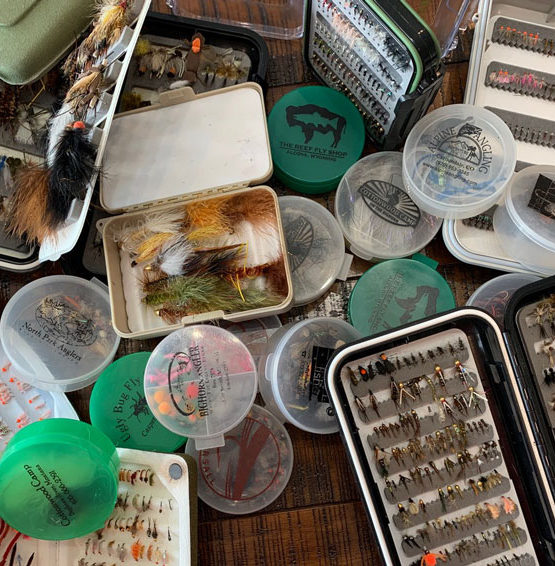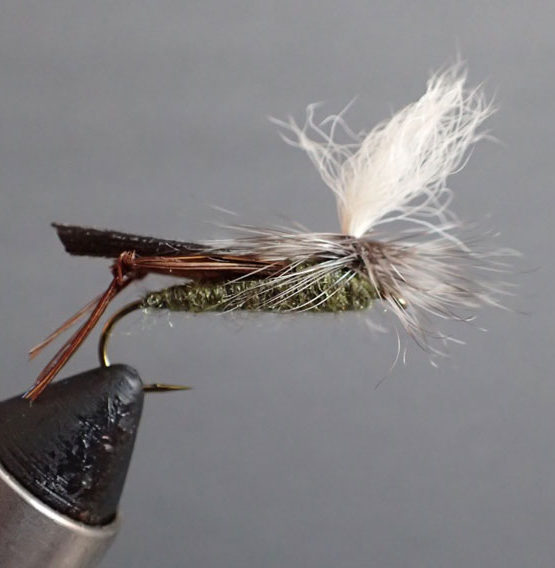Of all the fly fishing innovations through the years, parachute fly patterns stand out as one of the simplest, and greatest ideas ever to hit the market. Sure, things like large-arbor reels and fast-action fly rods might be a little more exciting, but at the end of the day, if you’re unable to spot your dry fly on the surface of that water, all that technology won’t do you much good.
That’s why, before we get any further, I want to address one of the most important questions a beginner can ask about fly fishing. What is a parachute fly pattern?
A parachute fly is just a normal dry fly pattern with the addition of a high-visibility post (i.e. parachute) that sticks straight up from the top of the fly. Additionally, parachute dry flies typically feature horizontally-wrapped hackle around the base of the post, which both imitates the legs of a fly and increases the pattern’s overall buoyancy.
In general, parachute flies are easier to see on the water and tend to float better than traditional dry flies; two things that can lead to quite a bit of fly fishing success.
But now that you know what a parachute fly is, the more important question is, which patterns should you actually add to your fly box? Well, I’m glad I asked that question for you, because, for the rest of this guide, I’m going to reveal five of my absolute favorite parachute flies.
Disclaimer: This post may contain affiliate links, meaning we will receive a small commission (at no cost to you) if you click through and make a purchase.5 Killer Parachute Fly Patterns
1. Parachute Adams
Of all the parachute flies out there, the very first pattern you should add to your fly box is the Parachute Adams. You see, unlike some of the other fly patterns on this list, the Parachute Adams doesn’t imitate a specific fly. Rather, you can get away with this little gem of a pattern in almost any dry fly hatch.
Seriously, I’ve personally used a Parachute Adams to imitate everything from caddis to mayflies and even emergers on occasion. It’s like the Swiss Army Knife of fly patterns. And quite honestly, it’s your duty as an angler to make sure you never run out of them.
You Might Also Like:
- What Is A Parachute Adams? And What Does It Imitate?
- 12 Killer Foam Flies You Need To Try
- 10 Best Midge Patterns For Trout
- 15 Best Nymphs For Colorado (Here’s What You Need)
- How To Keep Dry Flies From Sinking: 5 Simple Tips
- 25 Best Dry Flies For Colorado Fly Fishing
2. Parachute Hopper
If you like combing the banks and slamming some sick takes, then there’s no need for you to look any further than the Parachute Hopper. As the name suggests, this beauty of a fly pattern imitates a grasshopper.
However, despite the parachute, you don’t need to worry about a gentle landing with this one.
In fact, when casting a Parachute Hopper, you should actually try to slap the water a little bit–fish like it like that.
Oh, and after you get finished slapping the surface, don’t be afraid to give this one a little tug n’ wiggle. You’d be surprised how a little extra movement can heat up an afternoon on the water.
Wait, are we still talking about fly fishing?
3. Parachute Ant
Do you like to catch fish? Well, then it just so happens that I have the perfect fly pattern for you: the Parachute Ant.
While it doesn’t take a genius to figure out the kind of fly this pattern imitates, it will make you feel like a genius when you’re netting your 15th fish of the afternoon. That’s right, I said 15. Is that a guarantee? No. Is it a promise? Maybe. Should I keep writing? Probably not, but here we go anyway.
I’ve had a handful of really memorable days casting a Parachute Ant. And what’s surprising is that most of those days were spent on a lake. For some reason, the combination of still water and a juicy Parachute Ant is just too much for a trout to handle. That said, this pattern will work just about anywhere you can cast a fly rod. It doesn’t matter if your casting to a little trout on the bank of a small stream, or tasty Bows out in the middle of a lake, fish just can’t seem to resist the silhouette of a Parachute Ant.
4. Parachute Blue-Winged Olive (BWO)
The BWO is a staple fly pattern for just about every seasoned angler. I can attest that it’s one of the best flies you can keep in your fly box. However, based on my experience, you won’t find too many anglers fishing it in the parachute variety.
Why?
Well, I’m not really sure. My best guess is that they have the world’s most unbelievable eye-sight, because, to put it lightly, BWOs are freakin’ hard to spot on the water.
Luckily, for people like you and me who enjoy blinking while they watch their fly float down a river, the Parachute BWO is equally as effective (if not more effective) than the traditional BWO.
Trust me, that little white post can make a huge difference when you’re standing in the middle of a BWO hatch and fish are popping all around you.
5. Parachute Pale Morning Dun (PMD)
Along the same lines as the Parachute Adams and the Parachute BWO, the Parachute PMD is another great fly pattern to keep stocked in your fly box. While it might not be quite as versatile as the other two, it isn’t a pattern you want to be without should you ever get caught in a PMD hatch.
Like all the other flies on this list, I have had a ton of success with this pattern. And if you want to round out your fly box with a nice assortment of parachute flies, this is one that you shouldn’t neglect.
Bottom Line
Not only are parachute flies much easier to see on the surface of the water, but they also tend to float a lot better. Oh, and to top it all off, fish love them. So, if you want to step up your game as an angler, and hopefully find a little bit more success, I recommend adding a few of each of the patterns to your fly box.
Do you have a favorite parachute dry fly pattern? Be sure to let us know in the comments below!










